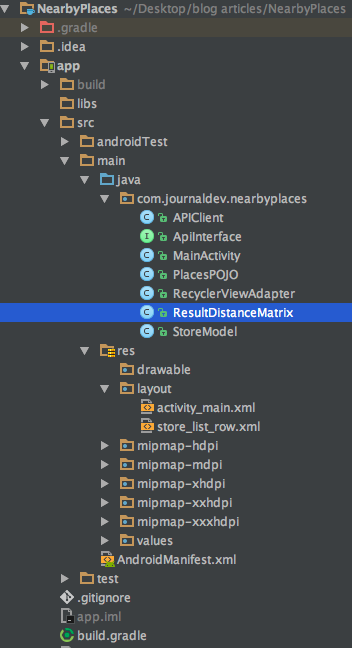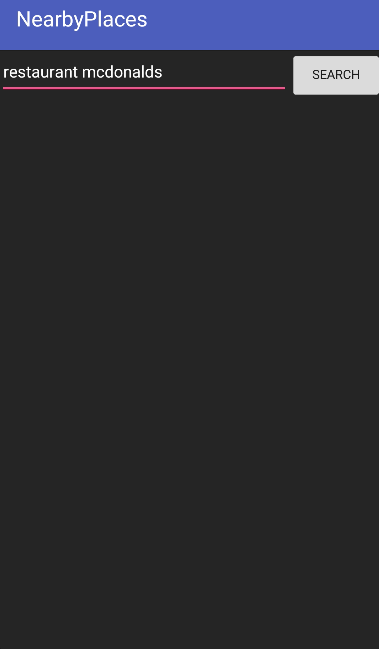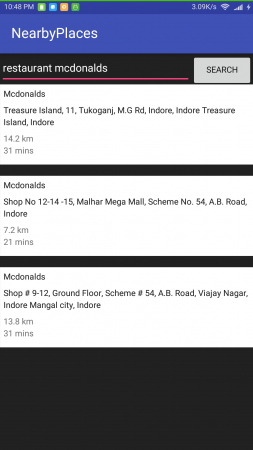Die Google Places API kann verwendet werden, um nahegelegene Orte zu finden. In diesem Tutorial entwickeln wir eine Anwendung, die die nahegelegenen Orte unserer Wahl zusammen mit der ungefähren Entfernung und Zeit von unserem aktuellen Standort anzeigt. Wir werden die Google Places API Web Service mit der Distance Matrix API in der Anwendung verwenden.
Google Places API
Die Google Places API Web Service ermöglicht es uns, Orte basierend auf einigen Parametern abzufragen, wie z.B. den Typ des Ortes, ob ein Ort gerade geöffnet ist, usw. Eine Nearby Search-Anfrage ist eine HTTP-URL in folgender Form:
https://maps.googleapis.com/maps/api/place/nearbysearch/output?parameters
json ist die empfohlene output-Option, die andere Option ist xml. Die erforderlichen Parameter sind:
- key(API-Schlüssel)
- location
- rankby=distance oder radius: Wenn einer verwendet wird, kann der andere nicht verwendet werden.
Hinweis: rankby=distance erfordert die Angabe eines der folgenden Parameter:
- name: Werte können mcdonalds, kfc usw. sein.
- type: Werte können restaurant, cafe usw. sein.
- keyword
Die optionalen Parameter können opennow, pagetoken usw. sein. Für weitere Details siehe diese Seite.
Google Distance Matrix API
Die Distance Matrix API wird verwendet, um die Entfernung und die Zeit zwischen zwei oder mehr Punkten zu berechnen. Eine Distance Matrix API-URL hat die Form:
https://maps.googleapis.com/maps/api/distancematrix/outputFormat?parameters
Die erforderlichen Parameter sind origins, destinations und der Schlüssel. origins – Dies enthält den Startpunkt für die Berechnung der Reiseentfernung und -zeit. Wir können mehr als einen Satz von Koordinaten durch Trennzeichen (|) übergeben. Wir können auch die Adressen/Ortskennungen anstelle von Koordinaten übergeben, und der Dienst wandelt sie automatisch in die Breitengrad-Längengrad-Koordinaten um, um Entfernung und Dauer zu berechnen. Beispielcode:
https://maps.googleapis.com/maps/api/distancematrix/json?origins=Washington,DC&destinations=New+York+City,NY&key=YOUR_API_KEY
Optionale Parameter sind:
- modus : dies erwartet einen Wert unter
fahren,radfahren,gehen,transit - vermeiden : Führt Einschränkungen für die Route ein, wie z.B.
maut,innenraumusw
Für weitere Details besuchen Sie diese Seite.
Aktivieren von API-Schlüsseln
Gehen Sie zu https://console.developers.google.com/ und aktivieren Sie die folgenden APIs:
- Google Maps Distance Matrix API
- Google Places API Web Service
- Google Places API für Android
Gehen Sie zu Berechtigungen und erstellen Sie einen neuen Schlüssel. Setzen Sie die Schlüsselbeschränkung vorerst auf Keine. Lassen Sie uns nun zum geschäftlichen Teil dieses Tutorials übergehen. Wir werden eine Anwendung entwickeln, die es uns ermöglicht, nahegelegene Orte basierend auf unserem aktuellen Standort zu suchen und die Orte in einem RecyclerView anzuzeigen. Wir werden Orte basierend auf den Typ- und Namenschlüsselwörtern suchen, die im EditText eingegeben und durch ein Leerzeichen getrennt werden. Beispiel: restaurant dominos oder cafe vegetarisch
Google Places API Beispielprojektstruktur
 Das Projekt besteht aus einer einzigen Aktivität. Eine Adapterklasse für den RecyclerView. Eine Modellklasse, die die Daten für jede RecyclerView-Zeile enthält. Zwei POJO-Klassen zum Konvertieren der JSON-Antworten in Gson von der Google Places API und der Distance Matrix API. APIClient und ApiInterface zum Verwenden von Retrofit und den Endpunkten.
Das Projekt besteht aus einer einzigen Aktivität. Eine Adapterklasse für den RecyclerView. Eine Modellklasse, die die Daten für jede RecyclerView-Zeile enthält. Zwei POJO-Klassen zum Konvertieren der JSON-Antworten in Gson von der Google Places API und der Distance Matrix API. APIClient und ApiInterface zum Verwenden von Retrofit und den Endpunkten.
Beispielcode für die Google Places API
Fügen Sie die folgenden Abhängigkeiten in die build.gradle-Datei ein
compile 'com.google.android.gms:play-services-location:10.2.1'
compile 'com.google.android.gms:play-services-places:10.2.1'
compile 'com.google.code.gson:gson:2.7'
compile 'com.squareup.retrofit2:retrofit:2.1.0'
compile 'com.squareup.retrofit2:converter-gson:2.1.0'
compile 'com.squareup.okhttp3:logging-interceptor:3.4.1'
compile 'com.squareup.okhttp3:okhttps:3.4.1'
compile 'io.nlopez.smartlocation:library:3.3.1'
compile 'com.android.support:cardview-v7:25.3.0'
compile 'com.android.support:recyclerview-v7:25.3.0'
compile 'io.nlopez.smartlocation:library:3.3.1' ist eine LocationTracking-Drittanbieter-Bibliothek, die den Boilerplate-Code reduziert. Der APIClient.java-Code ist unten angegeben:
package com.journaldev.nearbyplaces;
import java.util.concurrent.TimeUnit;
import okhttp3.OkHttpClient;
import okhttp3.logging.HttpLoggingInterceptor;
import retrofit2.Retrofit;
import retrofit2.converter.gson.GsonConverterFactory;
public class APIClient {
private static Retrofit retrofit = null;
public static final String GOOGLE_PLACE_API_KEY = "ADD_YOUR_API_KEY_HERE";
public static String base_url = "https://maps.googleapis.com/maps/api/";
public static Retrofit getClient() {
HttpLoggingInterceptor interceptor = new HttpLoggingInterceptor();
interceptor.setLevel(HttpLoggingInterceptor.Level.BODY);
OkHttpClient client = new OkHttpClient.Builder().readTimeout(30, TimeUnit.SECONDS).writeTimeout(30, TimeUnit.SECONDS).addInterceptor(interceptor).build();
retrofit = null;
retrofit = new Retrofit.Builder()
.baseUrl(base_url)
.addConverterFactory(GsonConverterFactory.create())
.client(client)
.build();
return retrofit;
}
}
Der ApiInterface.java-Code ist unten angegeben
package com.journaldev.nearbyplaces;
import retrofit2.Call;
import retrofit2.http.GET;
import retrofit2.http.Query;
public interface ApiInterface {
@GET("place/nearbysearch/json?")
Call<PlacesPOJO.Root> doPlaces(@Query(value = "type", encoded = true) String type, @Query(value = "location", encoded = true) String location, @Query(value = "name", encoded = true) String name, @Query(value = "opennow", encoded = true) boolean opennow, @Query(value = "rankby", encoded = true) String rankby, @Query(value = "key", encoded = true) String key);
@GET("distancematrix/json") // origins/destinations: LatLng as string
Call<ResultDistanceMatrix> getDistance(@Query("key") String key, @Query("origins") String origins, @Query("destinations") String destinations);
}
PlacesPOJO.java ist die Datei, die die Antwort von Places API enthält. Ihr Code ist unten angegeben
package com.journaldev.nearbyplaces;
import com.google.gson.annotations.SerializedName;
import java.io.Serializable;
import java.util.ArrayList;
import java.util.List;
public class PlacesPOJO {
public class Root implements Serializable {
@SerializedName("results")
public List<CustomA> customA = new ArrayList<>();
@SerializedName("status")
public String status;
}
public class CustomA implements Serializable {
@SerializedName("geometry")
public Geometry geometry;
@SerializedName("vicinity")
public String vicinity;
@SerializedName("name")
public String name;
}
public class Geometry implements Serializable{
@SerializedName("location")
public LocationA locationA;
}
public class LocationA implements Serializable {
@SerializedName("lat")
public String lat;
@SerializedName("lng")
public String lng;
}
}
ResultDistanceMatrix.java Klasse enthält die Antwort von Distance Matrix API. Ihr Code ist unten angegeben:
package com.journaldev.nearbyplaces;
import com.google.gson.annotations.SerializedName;
import java.util.List;
public class ResultDistanceMatrix {
@SerializedName("status")
public String status;
@SerializedName("rows")
public List<InfoDistanceMatrix> rows;
public class InfoDistanceMatrix {
@SerializedName("elements")
public List elements;
public class DistanceElement {
@SerializedName("status")
public String status;
@SerializedName("duration")
public ValueItem duration;
@SerializedName("distance")
public ValueItem distance;
}
public class ValueItem {
@SerializedName("value")
public long value;
@SerializedName("text")
public String text;
}
}
}
Die Datei activity_main.xml ist unten angegeben
<?xml version="1.0" encoding="utf-8"?>
<RelativeLayout xmlns:android="https://schemas.android.com/apk/res/android"
xmlns:tools="https://schemas.android.com/tools"
android:layout_width="match_parent"
android:layout_height="match_parent"
android:background="#212121"
tools:context="com.journaldev.nearbyplaces.MainActivity">
<EditText
android:id="@+id/editText"
android:layout_width="match_parent"
android:textColor="@android:color/white"
android:textColorHint="@android:color/white"
android:text="restaurant mcdonalds"
android:hint="type name"
android:layout_height="wrap_content"
android:layout_alignParentTop="true"
android:layout_toLeftOf="@+id/button"
android:layout_toStartOf="@+id/button" />
<Button
android:id="@+id/button"
android:layout_width="wrap_content"
android:layout_height="wrap_content"
android:layout_alignParentEnd="true"
android:layout_alignParentRight="true"
android:text="Search" />
<android.support.v7.widget.RecyclerView
android:id="@+id/recyclerView"
android:layout_width="match_parent"
android:layout_height="match_parent"
android:layout_below="@+id/editText"
android:scrollbars="vertical" />
</RelativeLayout>
Der Code für die Klasse MainActivity.java ist unten angegeben.
package com.journaldev.nearbyplaces;
import android.annotation.TargetApi;
import android.content.DialogInterface;
import android.content.pm.PackageManager;
import android.location.Location;
import android.os.Build;
import android.support.v7.app.AlertDialog;
import android.support.v7.app.AppCompatActivity;
import android.os.Bundle;
import android.support.v7.widget.LinearLayoutManager;
import android.support.v7.widget.RecyclerView;
import android.view.View;
import android.widget.Button;
import android.widget.EditText;
import android.widget.Toast;
import com.google.android.gms.maps.model.LatLng;
import java.util.ArrayList;
import java.util.List;
import io.nlopez.smartlocation.OnLocationUpdatedListener;
import io.nlopez.smartlocation.SmartLocation;
import retrofit2.Call;
import retrofit2.Callback;
import retrofit2.Response;
import static android.Manifest.permission.ACCESS_COARSE_LOCATION;
import static android.Manifest.permission.ACCESS_FINE_LOCATION;
public class MainActivity extends AppCompatActivity {
private ArrayList permissionsToRequest;
private ArrayList permissionsRejected = new ArrayList<>();
private ArrayList permissions = new ArrayList<>();
private final static int ALL_PERMISSIONS_RESULT = 101;
List storeModels;
ApiInterface apiService;
String latLngString;
LatLng latLng;
RecyclerView recyclerView;
EditText editText;
Button button;
List results;
@Override
protected void onCreate(Bundle savedInstanceState) {
super.onCreate(savedInstanceState);
setContentView(R.layout.activity_main);
permissions.add(ACCESS_FINE_LOCATION);
permissions.add(ACCESS_COARSE_LOCATION);
permissionsToRequest = findUnAskedPermissions(permissions);
if (Build.VERSION.SDK_INT >= Build.VERSION_CODES.M) {
if (permissionsToRequest.size() > 0)
requestPermissions(permissionsToRequest.toArray(new String[permissionsToRequest.size()]), ALL_PERMISSIONS_RESULT);
else {
fetchLocation();
}
} else {
fetchLocation();
}
apiService = APIClient.getClient().create(ApiInterface.class);
recyclerView = (RecyclerView) findViewById(R.id.recyclerView);
recyclerView.setNestedScrollingEnabled(false);
recyclerView.setHasFixedSize(true);
LinearLayoutManager layoutManager = new LinearLayoutManager(this);
recyclerView.setLayoutManager(layoutManager);
editText = (EditText) findViewById(R.id.editText);
button = (Button) findViewById(R.id.button);
button.setOnClickListener(new View.OnClickListener() {
@Override
public void onClick(View v) {
String s = editText.getText().toString().trim();
String[] split = s.split("\\s+");
if (split.length != 2) {
Toast.makeText(getApplicationContext(), "Please enter text in the required format", Toast.LENGTH_SHORT).show();
} else
fetchStores(split[0], split[1]);
}
});
}
private void fetchStores(String placeType, String businessName) {
/**
* For Locations In India McDonalds stores aren't returned accurately
*/
// Aufruf call = apiService.doPlaces(placeType, latLngString,"\""+ businessName +"\"", true, "distance", APIClient.GOOGLE_PLACE_API_KEY);
Call call = apiService.doPlaces(placeType, latLngString, businessName, true, "distance", APIClient.GOOGLE_PLACE_API_KEY);
call.enqueue(new Callback() {
@Override
public void onResponse(Call call, Response response) {
PlacesPOJO.Root root = response.body();
if (response.isSuccessful()) {
if (root.status.equals("OK")) {
results = root.customA;
storeModels = new ArrayList<>();
for (int i = 0; i < results.size(); i++) {
if (i == 10)
break;
PlacesPOJO.CustomA info = results.get(i);
fetchDistance(info);
}
} else {
Toast.makeText(getApplicationContext(), "No matches found near you", Toast.LENGTH_SHORT).show();
}
} else if (response.code() != 200) {
Toast.makeText(getApplicationContext(), "Error " + response.code() + " found.", Toast.LENGTH_SHORT).show();
}
}
@Override
public void onFailure(Call call, Throwable t) {
// Fehler hier protokollieren, da die Anfrage fehlgeschlagen ist
call.cancel();
}
});
}
private ArrayList findUnAskedPermissions(ArrayList wanted) {
ArrayList result = new ArrayList<>();
for (String perm : wanted) {
if (!hasPermission(perm)) {
result.add(perm);
}
}
return result;
}
private boolean hasPermission(String permission) {
if (canMakeSmores()) {
if (Build.VERSION.SDK_INT >= Build.VERSION_CODES.M) {
return (checkSelfPermission(permission) == PackageManager.PERMISSION_GRANTED);
}
}
return true;
}
private boolean canMakeSmores() {
return (Build.VERSION.SDK_INT > Build.VERSION_CODES.LOLLIPOP_MR1);
}
@TargetApi(Build.VERSION_CODES.M)
@Override
public void onRequestPermissionsResult(int requestCode, String[] permissions, int[] grantResults) {
switch (requestCode) {
case ALL_PERMISSIONS_RESULT:
for (String perms : permissionsToRequest) {
if (!hasPermission(perms)) {
permissionsRejected.add(perms);
}
}
if (permissionsRejected.size() > 0) {
if (Build.VERSION.SDK_INT >= Build.VERSION_CODES.M) {
if (shouldShowRequestPermissionRationale(permissionsRejected.get(0))) {
showMessageOKCancel("These permissions are mandatory for the application. Please allow access.",
new DialogInterface.OnClickListener() {
@Override
public void onClick(DialogInterface dialog, int which) {
if (Build.VERSION.SDK_INT >= Build.VERSION_CODES.M) {
requestPermissions(permissionsRejected.toArray(new String[permissionsRejected.size()]), ALL_PERMISSIONS_RESULT);
}
}
});
return;
}
}
} else {
fetchLocation();
}
break;
}
}
private void showMessageOKCancel(String message, DialogInterface.OnClickListener okListener) {
new AlertDialog.Builder(MainActivity.this)
.setMessage(message)
.setPositiveButton("OK", okListener)
.setNegativeButton("Cancel", null)
.create()
.show();
}
private void fetchLocation() {
SmartLocation.with(this).location()
.oneFix()
.start(new OnLocationUpdatedListener() {
@Override
public void onLocationUpdated(Location location) {
latLngString = location.getLatitude() + "," + location.getLongitude();
latLng = new LatLng(location.getLatitude(), location.getLongitude());
}
});
}
private void fetchDistance(final PlacesPOJO.CustomA info) {
Call call = apiService.getDistance(APIClient.GOOGLE_PLACE_API_KEY, latLngString, info.geometry.locationA.lat + "," + info.geometry.locationA.lng);
call.enqueue(new Callback() {
@Override
public void onResponse(Call call, Response response) {
ResultDistanceMatrix resultDistance = response.body();
if ("OK".equalsIgnoreCase(resultDistance.status)) {
ResultDistanceMatrix.InfoDistanceMatrix infoDistanceMatrix = resultDistance.rows.get(0);
ResultDistanceMatrix.InfoDistanceMatrix.DistanceElement distanceElement = infoDistanceMatrix.elements.get(0);
if ("OK".equalsIgnoreCase(distanceElement.status)) {
ResultDistanceMatrix.InfoDistanceMatrix.ValueItem itemDuration = distanceElement.duration;
ResultDistanceMatrix.InfoDistanceMatrix.ValueItem itemDistance = distanceElement.distance;
String totalDistance = String.valueOf(itemDistance.text);
String totalDuration = String.valueOf(itemDuration.text);
storeModels.add(new StoreModel(info.name, info.vicinity, totalDistance, totalDuration));
if (storeModels.size() == 10 || storeModels.size() == results.size()) {
RecyclerViewAdapter adapterStores = new RecyclerViewAdapter(results, storeModels);
recyclerView.setAdapter(adapterStores);
}
}
}
}
@Override
public void onFailure(Call call, Throwable t) {
call.cancel();
}
});
}
}
In dem obigen Code beginnen wir mit der Anforderung von Laufzeitberechtigungen, gefolgt von der Abfrage des aktuellen Standorts mit der SmartLocation-Bibliothek. Sobald das erledigt ist, übergeben wir das erste Wort aus dem EditText im Typ und das zweite Wort im Namen-Parameter der fetchStores()-Methode, die schließlich den Google Places API-Webdienst aufruft. Wir beschränken die Suchergebnisse auf 10. Für jedes Ergebnis berechnen wir die Entfernung und Zeit vom Geschäft innerhalb der Methode fetchDistance(). Sobald das für alle Geschäfte erledigt ist, füllen wir die Daten innerhalb der RecyclerViewAdapter.java-Klasse mithilfe einer Datenklasse StoreModel.java aus. Der Code für StoreModel.java ist unten angegeben:
package com.journaldev.nearbyplaces;
public class StoreModel {
public String name, address, distance, duration;
public StoreModel(String name, String address, String distance, String duration) {
this.name = name;
this.address = address;
this.distance = distance;
this.duration = duration;
}
}
Das Layout für jede Zeile des RecyclerView ist unten in der XML angegeben: store_list_row.xml
<?xml version="1.0" encoding="utf-8"?>
<LinearLayout xmlns:android="https://schemas.android.com/apk/res/android"
android:layout_width="match_parent"
android:layout_height="wrap_content"
android:layout_marginBottom="@dimen/activity_horizontal_margin"
android:orientation="vertical">
<android.support.v7.widget.CardView xmlns:card_view="https://schemas.android.com/apk/res-auto"
android:id="@+id/card_view"
android:layout_width="match_parent"
android:layout_height="wrap_content"
card_view:cardCornerRadius="0dp"
card_view:cardElevation="5dp">
<LinearLayout
android:layout_width="match_parent"
android:layout_height="wrap_content"
android:orientation="vertical"
android:padding="5dp">
<TextView
android:id="@+id/txtStoreName"
android:layout_width="wrap_content"
android:layout_height="wrap_content"
android:paddingBottom="5dp"
android:textColor="#212121" />
<TextView
android:id="@+id/txtStoreAddr"
android:layout_width="wrap_content"
android:layout_height="wrap_content"
android:paddingBottom="5dp"
android:textColor="#212121" />
<TextView
android:id="@+id/txtStoreDist"
android:layout_width="wrap_content"
android:layout_height="wrap_content"
android:paddingBottom="5dp" />
</LinearLayout>
</android.support.v7.widget.CardView>
</LinearLayout>
Der Code für RecyclerViewAdapter.java ist unten angegeben.
public class RecyclerViewAdapter extends RecyclerView.Adapter<RecyclerViewAdapter.MyViewHolder> {
private List<PlacesPOJO.CustomA> stLstStores;
private List<StoreModel> models;
public RecyclerViewAdapter(List<PlacesPOJO.CustomA> stores, List<StoreModel> storeModels) {
stLstStores = stores;
models = storeModels;
}
@Override
public MyViewHolder onCreateViewHolder(ViewGroup parent, int viewType) {
final View view = LayoutInflater.from(parent.getContext())
.inflate(R.layout.store_list_row, parent, false);
return new MyViewHolder(view);
}
@Override
public void onBindViewHolder(MyViewHolder holder, int position) {
holder.setData(stLstStores.get(holder.getAdapterPosition()), holder, models.get(holder.getAdapterPosition()));
}
@Override
public int getItemCount() {
return Math.min(5, stLstStores.size());
}
public class MyViewHolder extends RecyclerView.ViewHolder {
TextView txtStoreName;
TextView txtStoreAddr;
TextView txtStoreDist;
StoreModel model;
public MyViewHolder(View itemView) {
super(itemView);
this.txtStoreDist = (TextView) itemView.findViewById(R.id.txtStoreDist);
this.txtStoreName = (TextView) itemView.findViewById(R.id.txtStoreName);
this.txtStoreAddr = (TextView) itemView.findViewById(R.id.txtStoreAddr);
}
public void setData(PlacesPOJO.CustomA info, MyViewHolder holder, StoreModel storeModel) {
this.model = storeModel;
holder.txtStoreDist.setText(model.distance + "\n" + model.duration);
holder.txtStoreName.setText(info.name);
holder.txtStoreAddr.setText(info.vicinity);
}
}
}
Die Ausgabe der Beispielanwendung der Google Places API in Aktion lautet wie folgt:  Hinweis: Die Places API ist nicht genau für McDonald’s und einige Fast-Food-Ketten, insbesondere für Standorte in Indien. Ein Workaround besteht darin, den Wert im Parameter
Hinweis: Die Places API ist nicht genau für McDonald’s und einige Fast-Food-Ketten, insbesondere für Standorte in Indien. Ein Workaround besteht darin, den Wert im Parameter name in doppelte Anführungszeichen zu setzen, wie zum Beispiel:
Call call = apiService.doPlaces(placeType, latLngString,"\""+ businessName +"\"", true, "distance", APIClient.GOOGLE_PLACE_API_KEY);
Die Ausgabe für meinen Standort sieht folgendermaßen aus:  Damit endet dieses Tutorial. Sie können das finale Google Places API Beispielprojekt über den folgenden Link herunterladen.
Damit endet dieses Tutorial. Sie können das finale Google Places API Beispielprojekt über den folgenden Link herunterladen.
Source:
https://www.digitalocean.com/community/tutorials/google-places-api













